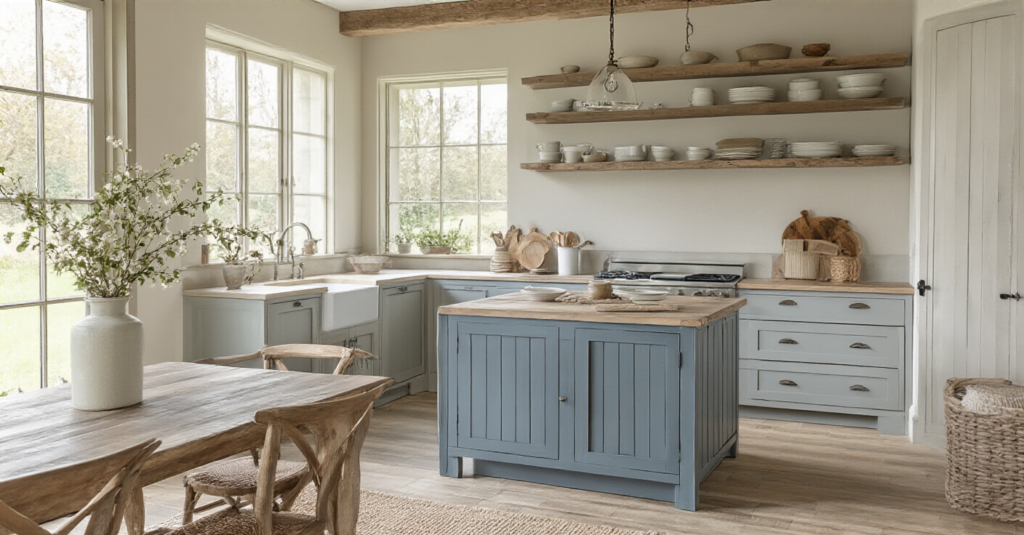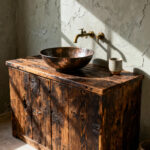I have to confess, I used to see “farmhouse” as just another trend destined for the big-box store clearance aisle. All shiplap and scripted signs telling you to “Gather.” It felt… manufactured. Then I went deep into my wellness architecture training, studying how our physical spaces have a measurable, scientific impact on our nervous systems, our stress levels, and our overall happiness.
And I had to eat my words.
Because when you strip away the trendy marketing, the core principles of authentic farmhouse design are actually the core principles of wellness design. It’s about bringing nature inside, celebrating imperfect and historical materials that ground us, reducing the visual and chemical noise of modern life, and creating a space that genuinely feels like a sanctuary. It’s not about buying a look. It’s about crafting a feeling.
So, let’s talk about what actually matters—the elements that will make your kitchen a place that not only looks good but actively contributes to your well-being. This is the stuff that makes a difference.
Laying the Farmhouse Foundation
1. Select the Perfect Rustic Color Palette for a Calming Atmosphere
Forget what’s “in” for a second and think about what’s calming. Our brains are hardwired to process massive amounts of visual information every second. A chaotic, high-contrast color scheme is like visual screaming—it keeps your nervous system on high alert. A true farmhouse palette, drawn from nature, does the opposite. Think creamy whites, soft sage greens, earthy grays, and muted blues. These colors are low in visual complexity, which tells your brain, “You can relax. You’re safe here.”

This isn’t just designer fluff. Color psychology shows that these gentle, natural tones can measurably lower blood pressure and reduce anxiety. It’s the foundational layer of a serene space. Start with a warm, soft white for the walls—not a sterile, blue-toned one—to create a quiet backdrop. This allows the warmth of the other materials, and your life, to be the star. It’s the single most impactful thing you can do to change how a room feels.
Now that we’ve quieted the background noise with color, let’s talk about the textures that make a space feel real and grounded.
2. Incorporate Timeless Wood Finishes and Distressed Elements Effectively
Our modern world is filled with flat, perfect, plastic surfaces. Our ancient brains don’t know what to do with that. They crave the patterns and textures found in nature. This deep, innate connection is called biophilia, and it’s why incorporating natural wood is so powerful. A reclaimed wood shelf or a distressed cabinet door isn’t just decor; it’s a direct link to the natural world that signals calm and stability to our subconscious.

The key here is “story.” A piece of wood with knots, grain, and even a few dings from a past life feels authentic. It has a history. That sense of permanence in a fast-moving world is incredibly grounding. The BS everyone tells you is that you have to buy something pre-distressed. No. The real magic comes from a salvaged beam or a piece of furniture you’ve had for ages. It’s about embracing imperfection, which gives you permission to be imperfect, too.
A client of mine had a perfectly nice, brand-new kitchen that she described as “soulless.” It was stressing her out. We swapped her sterile laminate island top for a thick, reclaimed butcher block. The whole room breathed a sigh of relief. The warmth and visible history of the wood became the anchor for everything else.
With that anchor in place, you need somewhere to display the things that bring you joy and make your life easier.
3. Choose Functional Open Shelving to Display Everyday Essentials
Okay, can we talk about open shelving? People either love it or are terrified of it. The wellness-focused truth is that it can be one of the best or worst things for your kitchen, depending on how you use it. When done right, it reduces “functional friction.” Having your everyday plates and glasses right there, ready to grab, removes a small but constant stressor—rummaging through cabinets.

The secret is ruthless curation. This is the BS part people get wrong. Open shelves are not for displaying every mug you’ve ever owned. That creates visual clutter, which is the enemy of a calm mind. Instead, think of it as a tool for mindfulness. You choose to display only the essential, beautiful items you use daily. A matched set of white dishes, your favorite hand-thrown mugs, a few glass jars. The result is an honest, functional display that makes your daily rituals easier and more beautiful.
After my own kitchen renovation, I put in a small section of open shelving. It forced me to get rid of a dozen mismatched, chipped mugs I was holding onto for no reason. Now, reaching for my morning coffee cup is a simple, peaceful moment instead of a chaotic search. It’s a tiny change that starts the day on a better note.
And right below those shelves, you need a sink that works as hard as it looks good.
4. Feature a Statement Farmhouse Sink as a Kitchen Centerpiece
Everyone loves the look of a farmhouse sink, but let me tell you the secret reason your body will love it even more: ergonomics. A standard undermount sink forces you to lean forward over a slice of countertop, putting a constant strain on your lower back. A farmhouse sink, with its front apron, pulls the basin closer to you. You can stand straighter, reducing that strain significantly. For something you use multiple times a day, this is a huge wellness upgrade.
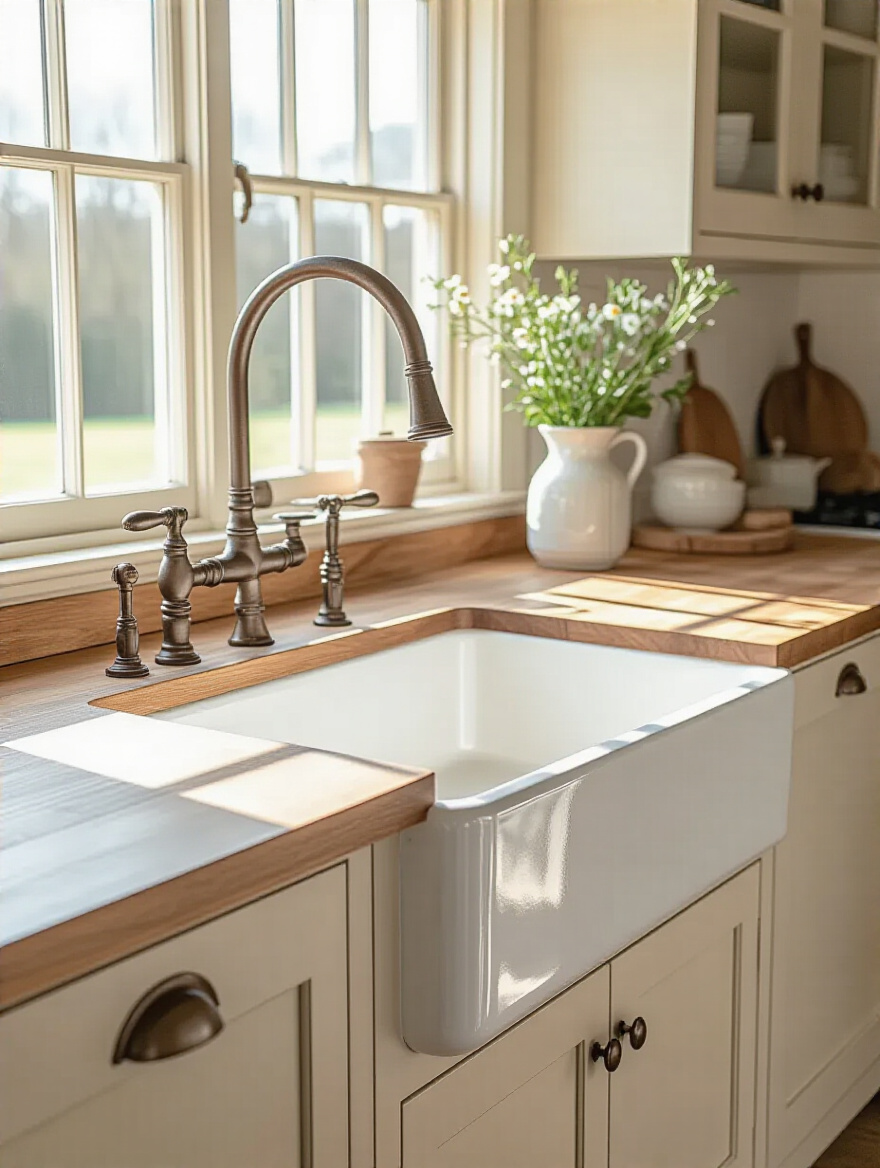
Of course, it’s also a powerful aesthetic anchor. Its substantial size and presence give the kitchen a grounding focal point, a sense of permanence and tradition. Whether you choose classic white fireclay, which feels clean and bright, or something like soapstone or copper for a deeper, moodier vibe, the sink becomes the heart of the workspace. It’s a design choice that says, “This is a real kitchen, for a real family, where real life happens.”
My shortcut for this? Get one with a built-in ledge for accessories like a cutting board or a colander. This turns your sink into a multifunctional prep station, which is an incredible space-saver in any kitchen and makes the workflow so much more intuitive.
Building on that idea of permanence and history, let’s dig a little deeper into the materials that give a space its soul.
5. Utilize Reclaimed Materials for Authentic Character and Warmth
If there is one shortcut to creating a space with instant soul, it’s using reclaimed materials. I’m talking about old barn wood for a feature wall, antique floorboards that still whisper of their past life, or salvaged metal fixtures. From a wellness perspective, these materials do two amazing things. First, they connect us to a story, to history, which is deeply grounding. They remind us that we’re part of a continuum.

Second, they are often healthier for your home. New, mass-produced building materials can spend years off-gassing volatile organic compounds (VOCs), which pollute your indoor air. Truly old materials have already done their off-gassing decades ago. You’re bringing in character without the chemicals. That’s a massive win for the health of your home and your family. I always tell my clients to find a local architectural salvage yard—it’s a treasure hunt that pays off in ways a home goods store never can.
Functional Charm & Smart Storage Solutions
6. Curate Vintage-Inspired Baskets for Stylish Storage Solutions
Clutter is stress. Period. Every object sitting out is a tiny, unresolved to-do list item for your brain. Baskets are the antidote. They are the epitome of “contained coziness.” By corralling mail, root vegetables, or kids’ snacks into a beautiful woven basket, you’re not just tidying up—you’re quieting the visual noise. You’re giving your mind fewer things to process, which frees up mental energy.
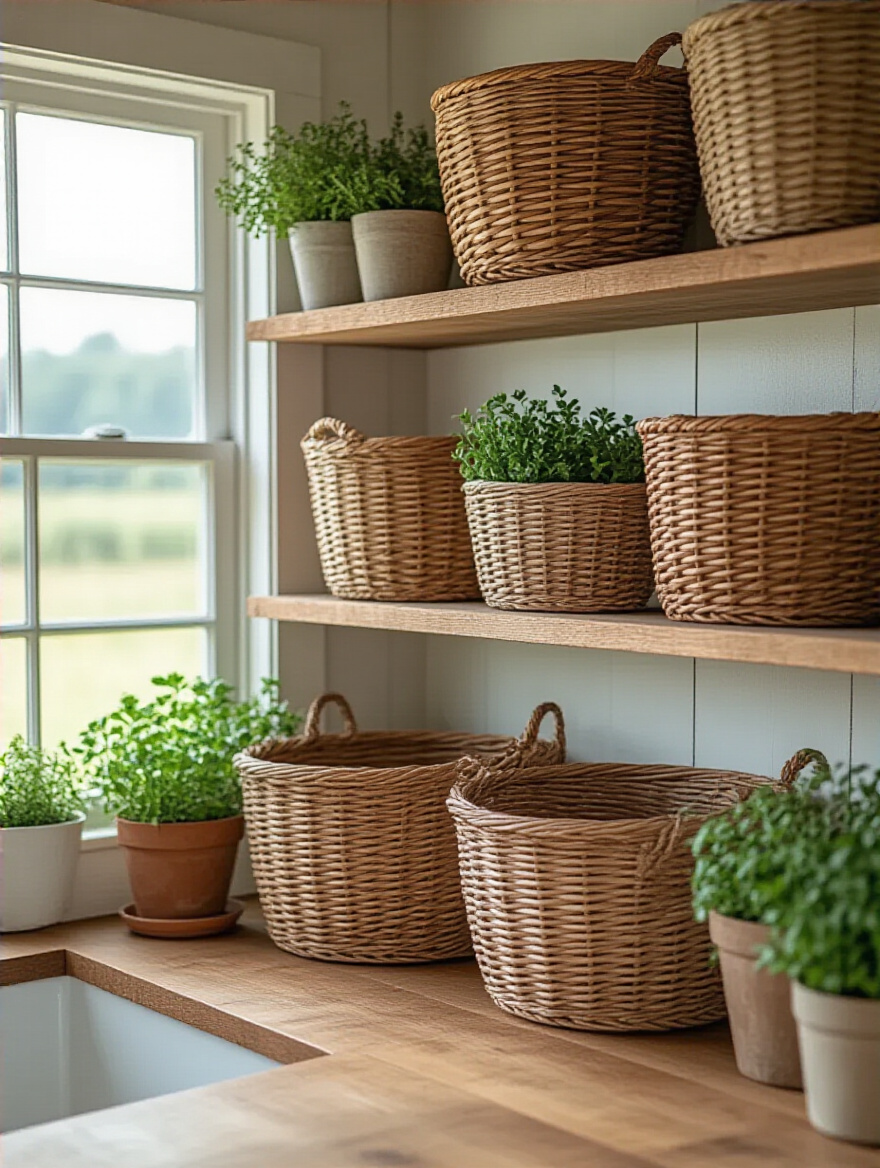
And let’s talk texture. The natural weave of a rattan or seagrass basket provides a soft, organic counterpoint to all the hard surfaces in a kitchen—the stone counters, the tile backsplash, the metal appliances. That textural variety is deeply satisfying to our senses. It makes a space feel layered, complete, and infinitely more comfortable. Just don’t go overboard; a few strategically placed baskets are all you need.
A quick tip: use them for things you need to access often but don’t want to look at. Think of them as a beautiful veil for the less-than-beautiful parts of daily life.
Speaking of making things accessible, let’s look up.
7. Maximize Wall Space with Decorative Pot Racks and Utensil Holders
I see so many clients with beautiful, expensive cookware hidden away in a jumble at the back of a low cabinet. The daily ritual of cooking starts with the stressful, clanging archeological dig for the right pan. Hanging your most-used pots and utensils on a wall-mounted rack is a game-changer for your workflow. It puts everything you need in sight and within reach.
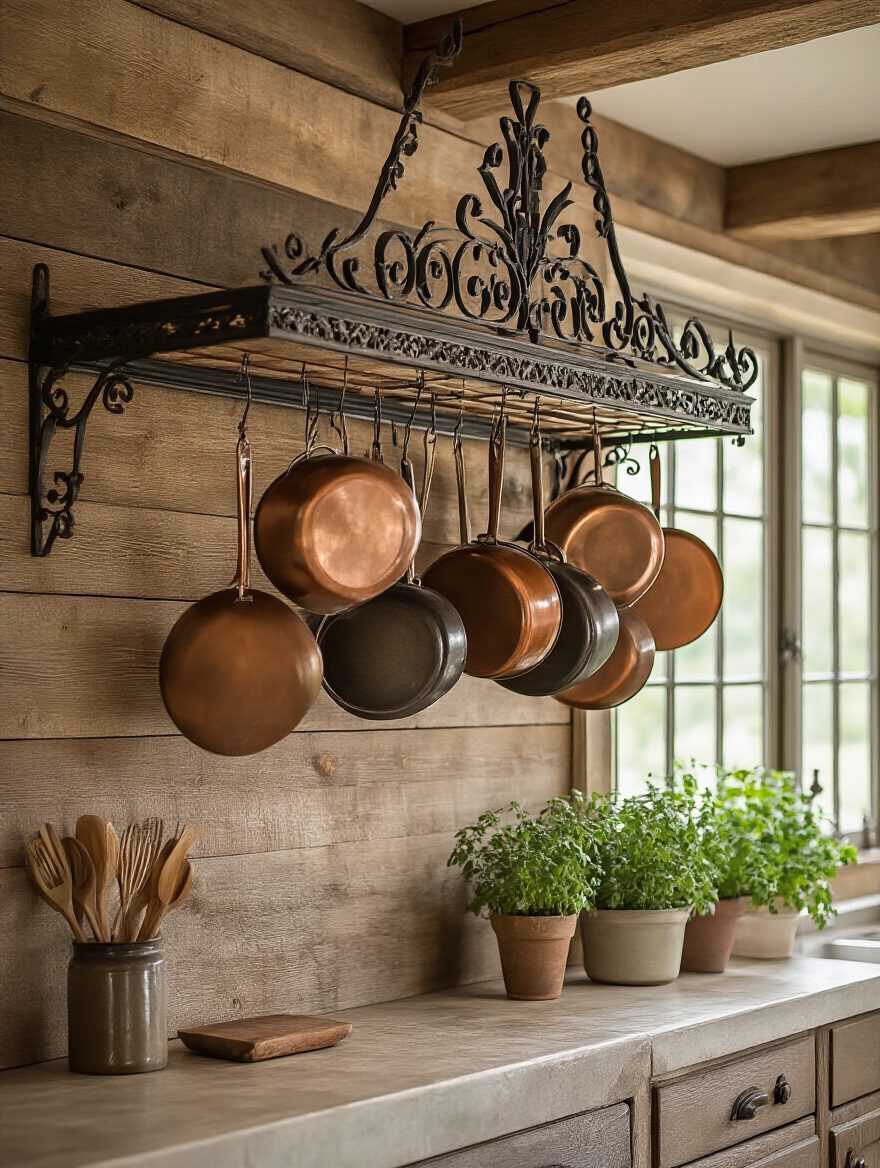
This isn’t about showing off. It’s about designing a space that supports your activities, not one that works against them. By making your tools part of the decor, you celebrate the act of cooking. It’s an honest, utilitarian approach that is the heart of true farmhouse style. A simple wrought iron or copper rail with S-hooks makes everyday tasks smoother, easier, and less stressful. That’s good design.
Next up, let’s bring that same visibility and order to your pantry staples.
8. Employ Apothecary Jars for Beautiful and Organized Pantry Staples
Your pantry can be a source of calm or a source of chaos. Stacks of half-empty bags and mismatched boxes are visual clutter, and they make it impossible to know what you actually have. The result? You buy a third bag of lentils when you already have two. Apothecary jars solve this beautifully. Transferring dry goods like flour, oats, pasta, and nuts into clear glass jars creates instant order.
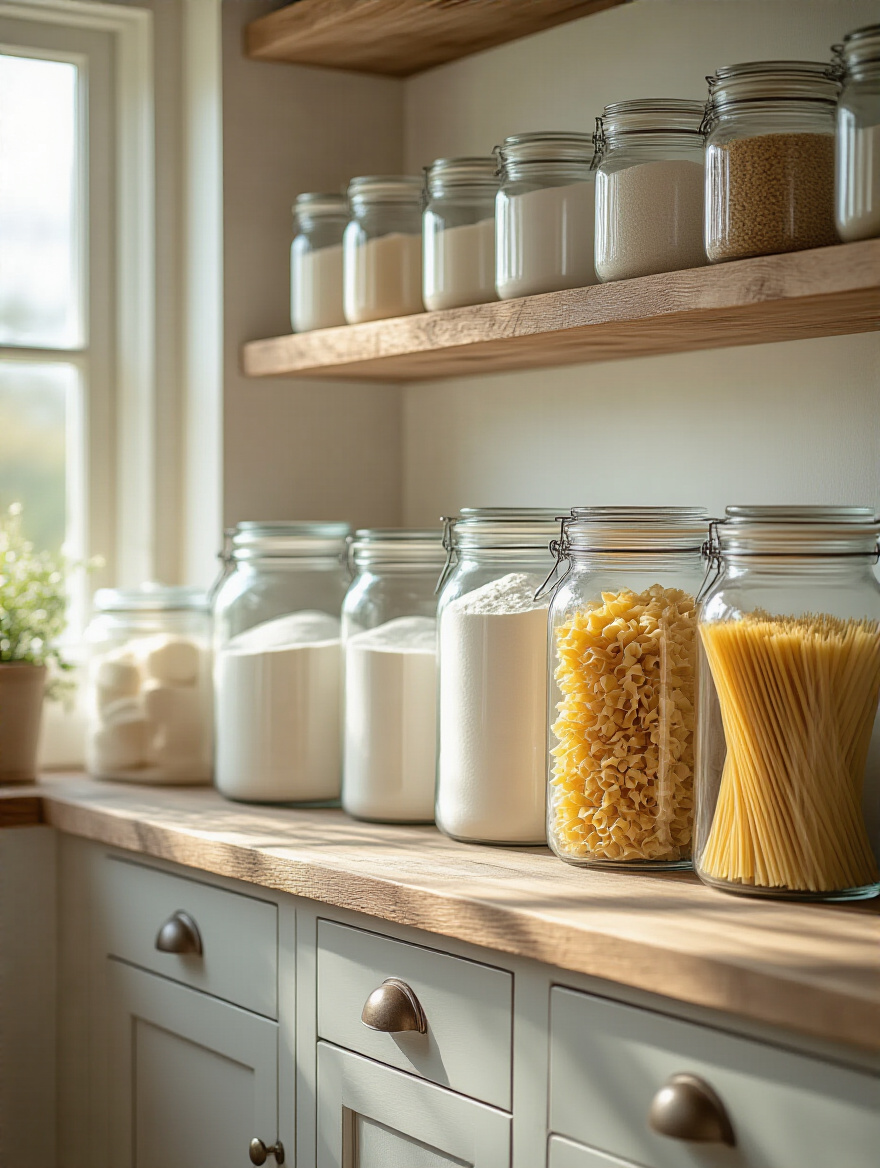
From a wellness standpoint, this system has two huge benefits. First, you’re getting your food out of plastic packaging and into inert glass, which is better for your health. Second, it creates a “visual inventory.” At a glance, you know exactly what you have and what you need. This reduces mental load and food waste. It turns your pantry into a calm, functional, and surprisingly beautiful part of your kitchen. Don’t skip the labels—even I can’t tell baking soda from baking powder by sight.
Once your ingredients are beautifully organized, let’s talk about the tools you use to prepare them.
9. Introduce Cutting Boards and Wooden Dough Bowls as Textured Decor
Some of the most beautiful objects in a home are the ones that are meant to be used. I’m a huge advocate for “functional beauty,” and wooden cutting boards are the perfect example. Instead of hiding them away, lean a collection of them against your backsplash. Their varied shapes, sizes, and wood tones add so much warmth and texture. It’s an effortless way to break up a monotonous wall of tile.
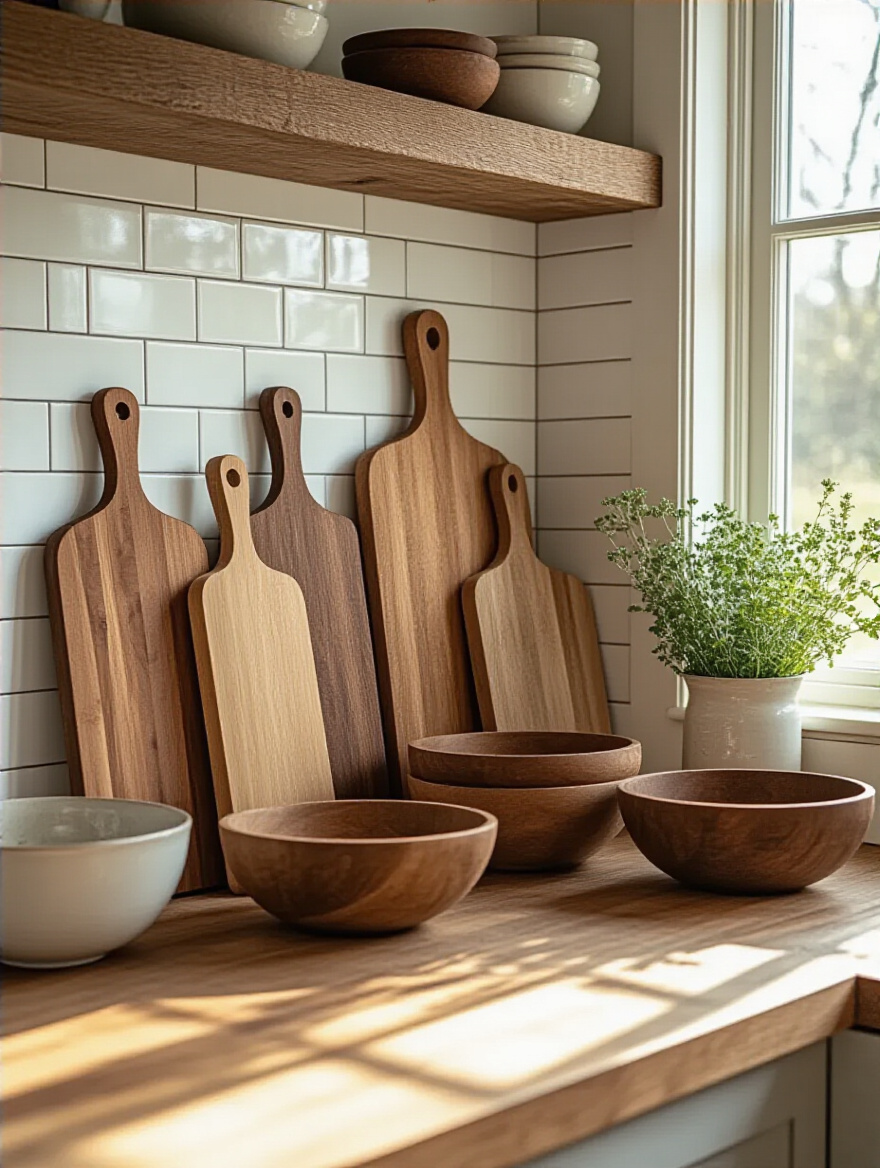
The same goes for a big wooden dough bowl. It’s a sculpture you can use. Placed on an island or table, it can be a “drop zone” for keys and mail, or a beautiful vessel for fruit. These pieces bring an organic, touchable element into the kitchen. Running your hand over the smooth, worn wood is a small, grounding moment in your day. They are beautiful because they are useful, and useful because they are beautiful.
Now, let’s add a different kind of material to the mix for some much-needed balance.
10. Utilize Galvanized Metal Bins for Industrial Farmhouse Flair
A room that’s all soft woods and creamy whites can sometimes feel a bit one-note. True farmhouse style isn’t just soft and sweet; it has a sturdy, industrial backbone. That’s where galvanized metal comes in. Its cool, matte, utilitarian finish provides a wonderful contrast to the warmth of wood and the softness of textiles. It’s the visual equivalent of a pinch of salt in a sweet recipe—it brings out the flavor of everything else.
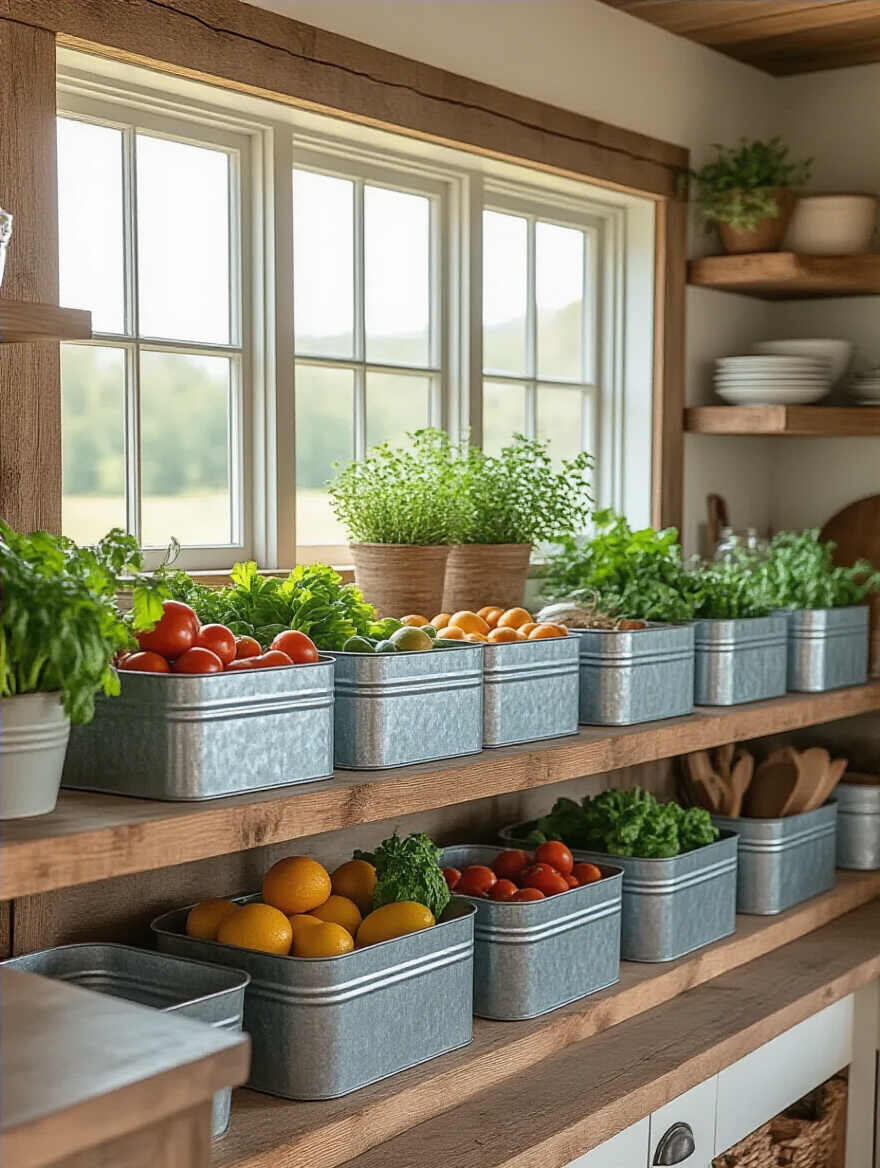
Use galvanized bins to hold cleaning supplies under the sink, as a planter for a fiddle-leaf fig, or as a caddy for oils and vinegars by the stove. It adds a touch of rugged honesty to the space. It says, “This is a workshop. This kitchen works for a living.” That balance between the rustic and the industrial, the soft and the hard, is what makes the aesthetic feel so dynamic and real.
Adding Character & Personal Touches
11. Style Collections of White Ceramics for a Classic, Cohesive Look
If your open shelves feel a little chaotic, a collection of white ceramics is your shortcut to calm. By gathering pitchers, bowls, and platters in a single, cohesive color, you’re creating what designers call a “visual resting place.” Your eye sees the collection as one unit instead of a dozen different objects, which immediately reduces mental clutter.
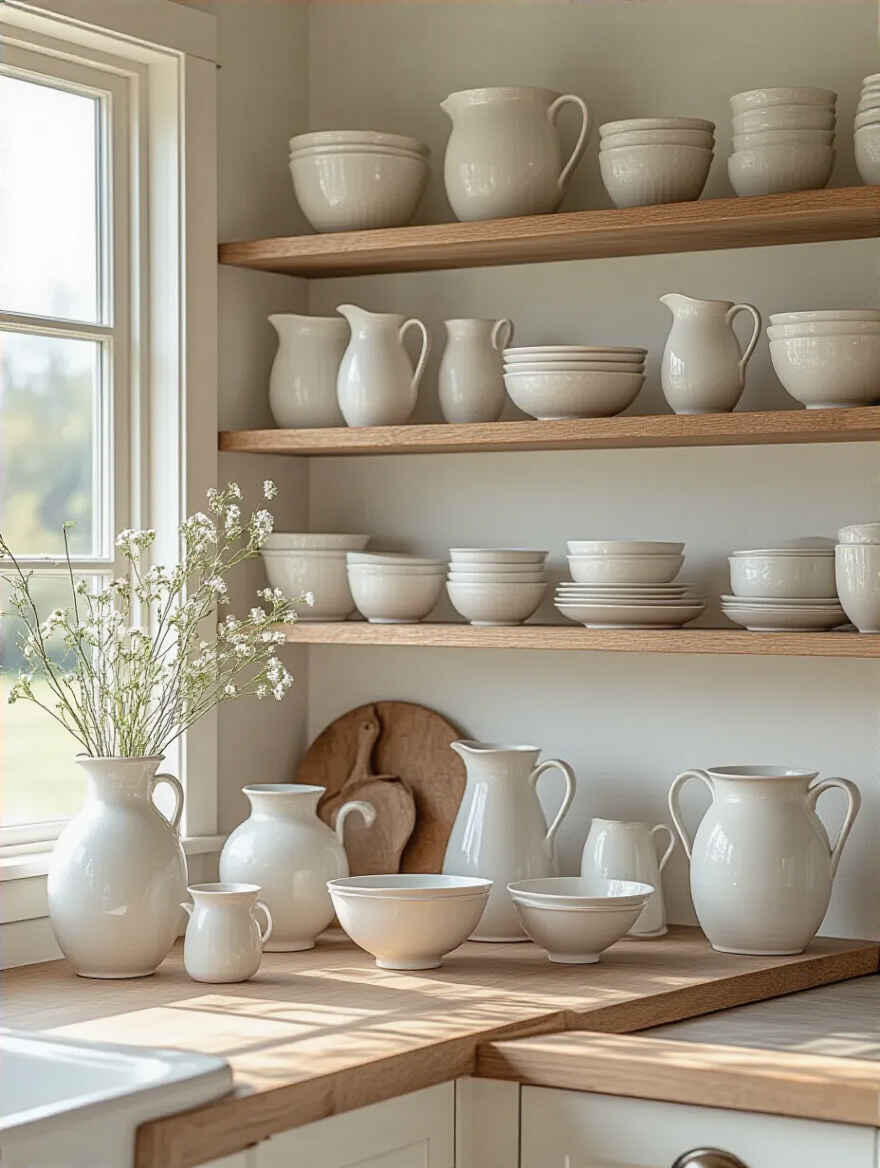
The magic of white is that it reflects light, making your kitchen feel brighter and more spacious, which is a known mood-booster. It’s a clean, serene backdrop that allows the form and texture of each piece to shine. A key tip from my own experience: mix new pieces with vintage ones. Look for old ironstone pitchers or platters at flea markets. Their slight imperfections and creamy tones add a layer of soul that brand-new ceramics just can’t match.
After setting that clean, calm stage, it’s time to bring in the pieces that tell your unique story.
12. Introduce Antiques and Flea Market Finds for Story and Warmth
Here’s the thing about a room filled with only brand-new stuff: it has no soul. A home needs a history. It needs objects that carry a story. This is where antiques and flea market finds become so vital. An old wooden stool tucked into a corner, a vintage scale on a shelf, a faded landscape painting—these aren’t just objects. They are conversation starters. They are anchors to the past.
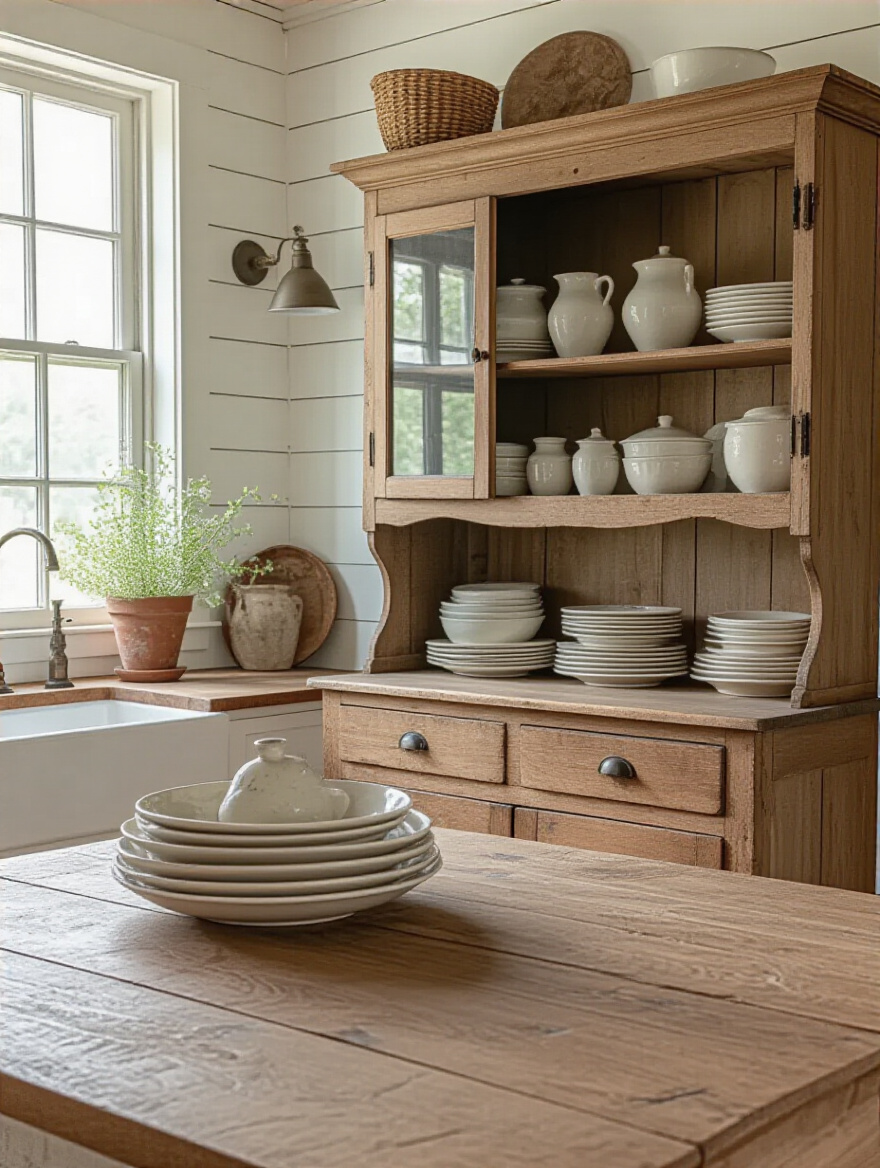
I once worked with a family whose kitchen felt cold and impersonal. During our consultation, I noticed an old, handwritten recipe card from the husband’s grandmother. We had it professionally framed and hung it in the breakfast nook. It instantly became the heart of the room. It was personal, meaningful, and told a beautiful story. Your home should tell your story. And the best stories are often found in the things that have lived a life before they came to you.
As you fill your space with stories, don’t forget to add a bit of life.
13. Bring Nature Indoors with Fresh Herbs and Greenery Displays
This is the most direct and powerful wellness tip on this entire list. Bringing living plants into your home is non-negotiable for a healthy space. We’ve already talked about biophilia—our innate connection to nature. Plants are the most literal expression of that. They have been scientifically proven to lower cortisol (the stress hormone), boost focus, and purify the air.

A small pot of basil on the windowsill isn’t just for your next pasta dish; it’s a living, breathing part of your home’s ecosystem. A hanging pothos with vines trailing down a cabinet softens hard lines and adds vibrant life. For a busy client who insisted she had a “black thumb,” we started with one snake plant, which is nearly indestructible. Even that one plant made a noticeable difference in how she felt in her kitchen. It made the room feel alive.
While plants bring life, the next step is about bringing your life into the space.
14. Personalize Spaces with Meaningful Artwork and Family Photos
Please, I’m begging you, don’t buy generic “art” from a big-box store. Your walls are valuable real estate for things that matter to you. A kitchen can feel like a purely functional space, but adding personal photos and meaningful artwork turns it into the emotional heart of the home. Seeing a candid photo of your kids laughing or a piece of art you bought on a memorable trip triggers a positive emotional response. It’s a constant, subtle reminder of what you love.
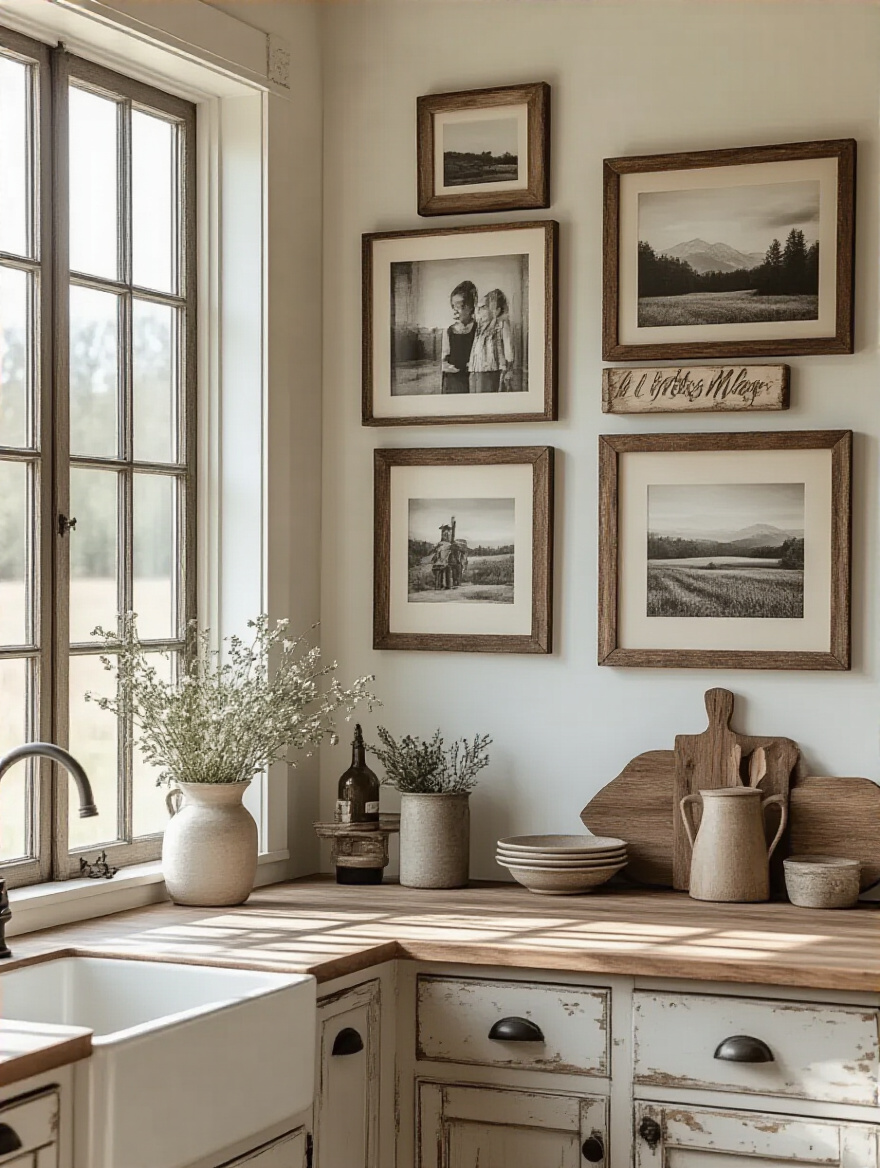
Create a small gallery wall in a breakfast nook or lean a few framed photos on an open shelf.
A space is only a sanctuary if it reflects the people who live there. Your art and photos are the most direct way to infuse your personality and your love into the very walls of your home.
It’s the single best way to make a house feel like your home.
Ambiance & Finishing Touches
15. Enhance Warmth with Strategic Lighting Fixtures and Dimmer Switches
If you do nothing else, do this: put every single light in your kitchen on a dimmer switch. This is the biggest, most impactful secret of wellness design. Our bodies are designed to sync with the natural light cycles of the sun. Bright, cool light during the day signals “energy and focus.” Soft, warm light in the evening signals “relax and prepare for rest.” Most standard kitchen lighting is stuck on one setting: “interrogation room bright.”
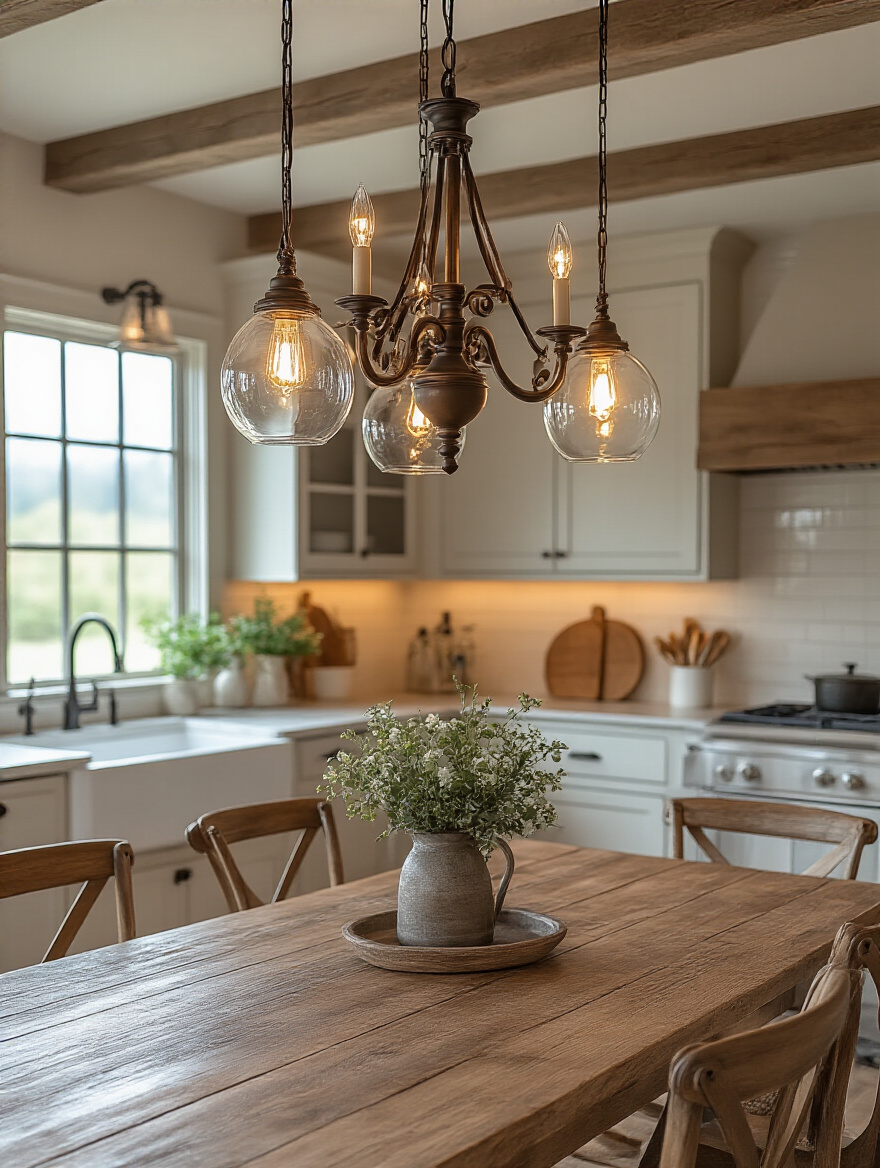
By layering your lighting—ambient (a central fixture), task (under cabinets), and accent (a small lamp)—and putting it all on dimmers, you gain full control over the mood and biological signals in your space. Bright for cooking, soft and warm for dinner. This simple change helps regulate your circadian rhythm, which improves sleep, mood, and overall health. It is the most powerful tool you have for shaping the feeling of a room.
Once the lighting is right, you can add the final layers of softness.
16. Drape Natural Fiber Textiles like Linen and Cotton for Softness
Kitchens are full of hard, reflective surfaces: stone, steel, tile. This can make them feel cold and noisy. The solution is to add softness. Textiles like linen and cotton are essential for absorbing sound and adding tactile comfort. A simple linen café curtain filters light beautifully, a stack of soft cotton tea towels adds texture, and a simple cushion on a bench invites people to stay a while.
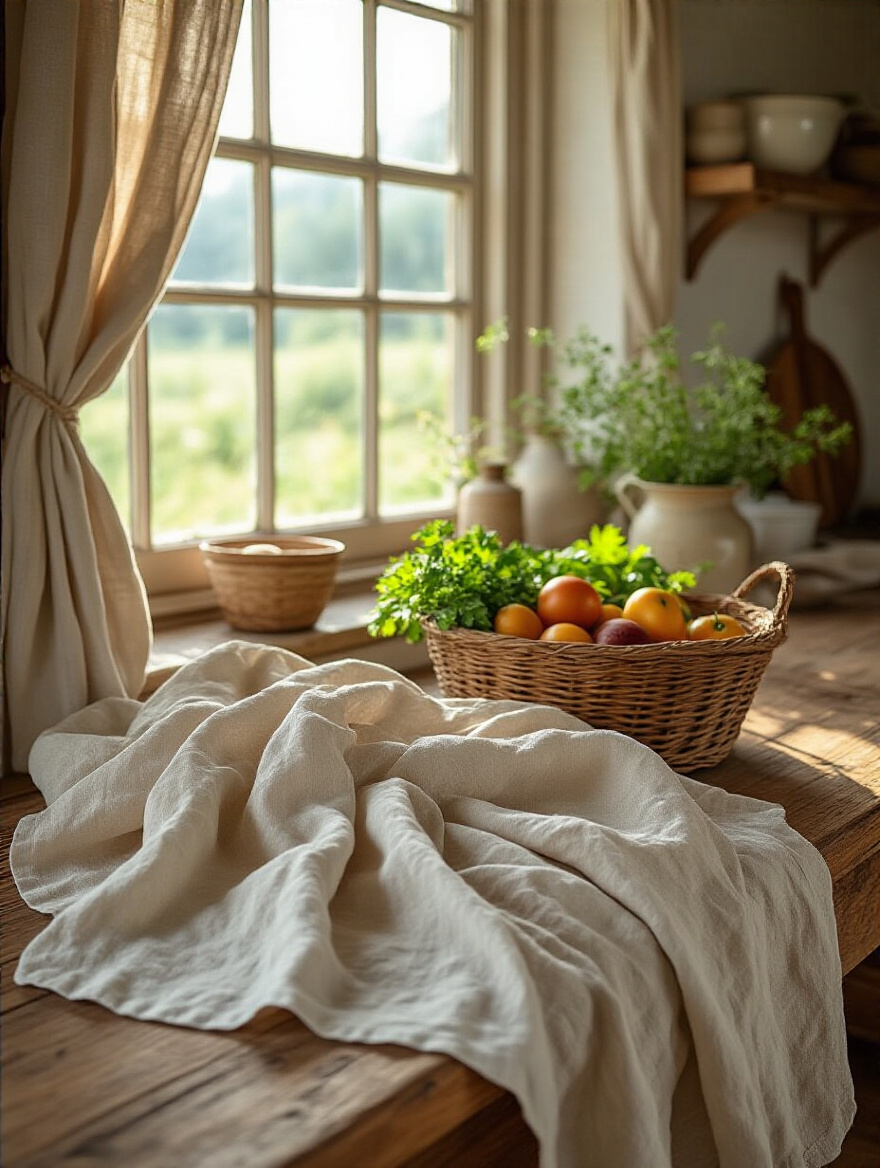
I learned this the hard way in my first apartment. My kitchen was a jarring echo chamber until I added a simple woven runner on the floor and hung a few tea towels on hooks. The difference was immediate. The room felt ten times calmer and more inviting. Embrace the natural wrinkles in linen—that relaxed, imperfect quality is part of its charm and perfectly fits the farmhouse ethos.
Now for a touch of architectural history that makes a space feel truly unique.
17. Place Subtle Architectural Salvage for Unique Visual Interest
This is the advanced level of incorporating history. While an antique is an object you place in a room, architectural salvage is an object you build into the room. Think a pair of old, weathered corbels used to support an open shelf, an antique newel post used as the corner of an island, or a vintage tin ceiling tile framed as art.
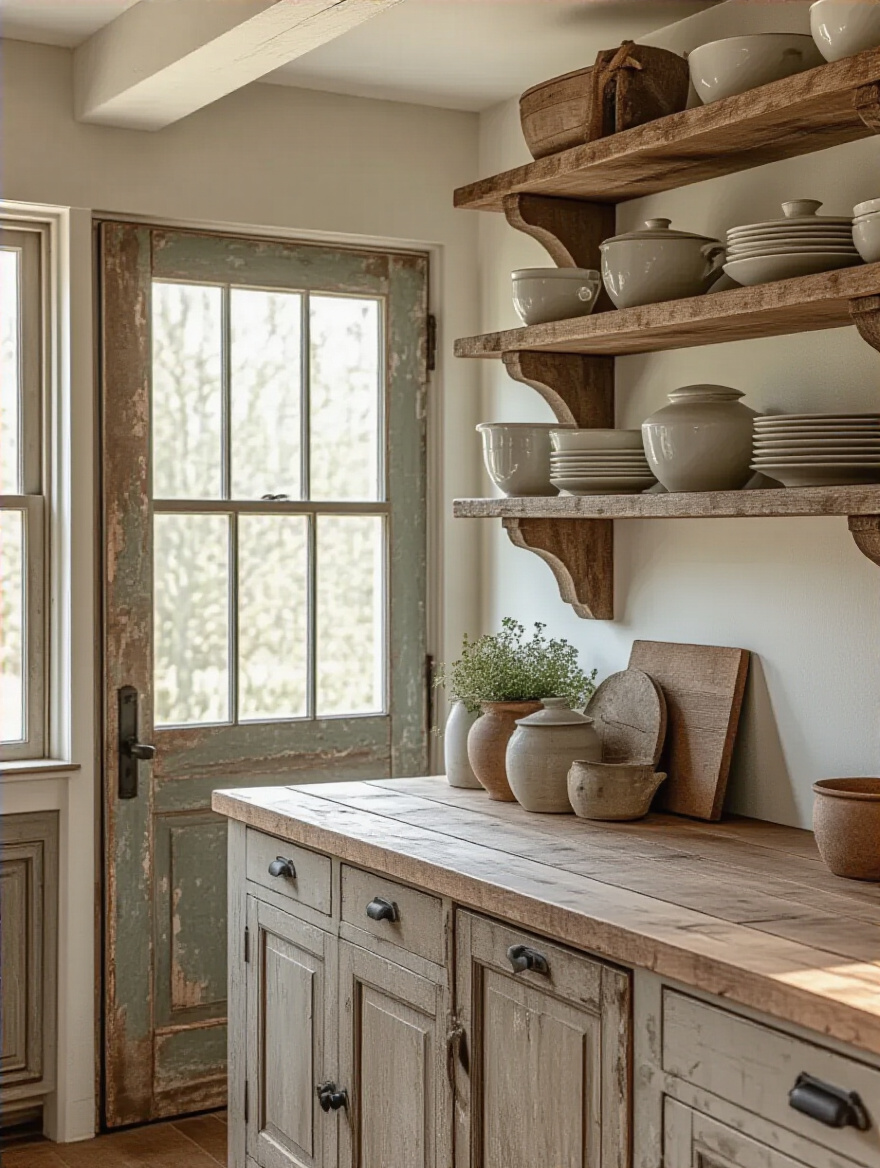
These pieces bring a sense of gravity and authenticity that is impossible to replicate with new materials. They suggest that the room has evolved over time, that it has a deep and solid history. One or two thoughtfully placed pieces are all you need. They act as punctuation marks in the design, creating unique focal points that are rich with story and character. It’s a shortcut to making a new kitchen feel like it’s always been there.
And for our final touch, let’s add one last whisper of nature.
18. Arrange Dried Flowers or Wheat Sheaves for Timeless Farmhouse Appeal
Fresh flowers are beautiful, but they are fleeting. Dried botanicals, on the other hand, offer an enduring, gentle connection to the natural world. A bunch of dried lavender in a crock, a sheaf of wheat in a tall vase, or a cluster of eucalyptus branches in a vintage pitcher brings texture and a muted, organic beauty that lasts for months or even years.
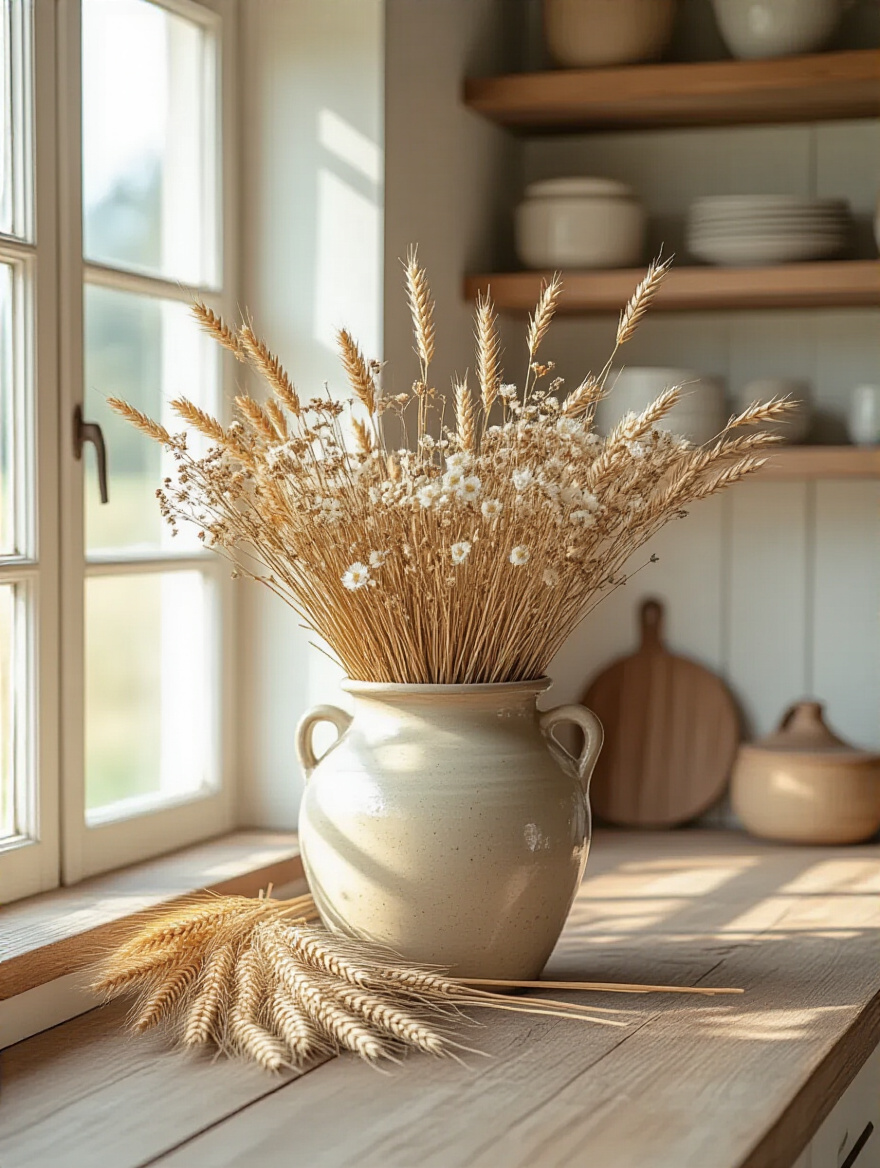
There is a quiet, poetic quality to dried botanicals. They represent the beauty of every season of life, not just the full bloom of spring. They add a final layer of soft texture and rustic elegance that feels effortless and timeless. It’s the perfect finishing touch—a gentle, lasting reminder of the wild and beautiful world just outside your door.
Conclusion
Creating a farmhouse kitchen that truly nurtures you has nothing to do with chasing trends and everything to do with being intentional. It’s about understanding the “why” behind each choice. Why a calming color palette? To soothe your nervous system. Why natural materials? To ground you and connect you to nature. Why personal touches? To fill your home with your own story.
By focusing on these foundational principles of wellness design—natural light, authentic materials, personal stories, and a connection to the outdoors—you’re not just decorating. You are actively crafting an environment that supports your health, calms your mind, and genuinely feels like a sanctuary. This is the true heart of the farmhouse aesthetic, and it’s a feeling that will never go out of style.
